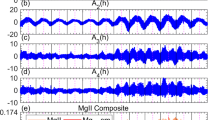Abstract
An approach to modeling the regional ionospheric total electron content (TEC) based on spherical cap harmonic analysis is presented. This approach not only provides a better regional TEC mapping accuracy, but also the capability for ionospheric model prediction based on spectrum analysis and least squares collocation. Unlike conventional approaches, which predict the immediate TEC with models using current observations, the spherical cap harmonic approach utilizes models using past observations to predict a model which will provide future TEC values. A significant advantage in comparison with conventional approaches is that the spherical cap harmonic approach can be used to predict the long-term TEC with reasonable accuracy. This study processes a set of GPS data with an observation time span of 1 year from two GPS networks in China. The TEC mapping accuracy of the spherical cap harmonic model is compared with the polynomial model and the global ionosphere model from IGS. The results show that the spherical cap harmonic model has a better TEC mapping accuracy with smoother residual distributions in both temporal and spatial domains. The TEC prediction with the spherical cap harmonic model has been investigated for both short- and long-term intervals. For the short-term interval, the prediction accuracies for the latencies of 1-day, 2-days, and 3-days are 2.5 TECU, 3.5 TECU, and 4.5 TECU, respectively. For the long-term interval, the prediction accuracy is 4.5 TECU for a 2-month latency.













Similar content being viewed by others
References
Georgiadou Y (1994) Modeling the ionosphere for an active control network of GPS station. LGR-series (7), Delft Geodetic Computing Centre, Delft
Georgiadou Y, Kleusberg A (1988) On the effect of ionospheric delay on geodetic relative GPS positioning. Manuscripta Geodaetia 13:1–8
Haines GV (1985) Spherical cap harmonic analysis. J Geophys Res 90(B3):2583–2591
Haines GV (1988) Computer programs for spherical cap harmonic analysis of potential and general fields. Comput Geosci 14(4):413–447
Komjathy A (1997) Global ionospheric total electron content mapping using the global positioning system. Dissertation, University of New Brunswick
Li J (1993) The spectral methods in physical geodesy. Dissertation, Wuhan Technical University of Surveying and Mapping
Liu J (2008) SCHA analysis and predication of regional ionospheric TEC using ground-based GPS measurements. Dissertation, Wuhan University
Liu Z, Gao Y (2004) Ionospheric TEC predictions over a local area GPS reference network. GPS Solut 8(1):23–29
Liu J, Wang Z, Zhang H, Zhu W (2008a) Comparison and consistency research of regional ionospheric TEC models based on GPS measurements. Geomat and Inf Sci of Wuhan University 33(5):479–483
Liu J, Wang Z, Wang H, Zhang H (2008b) Modeling regional ionosphere using GPS measurements over China by spherical cap harmonic analysis methodology. Geomat and Inf Sci of Wuhan University 33(8):792–795
Parkinson BW, Spilker JJ (1996) Global positioning system: theory and applications, vol I and II. American Institute of Aeronautics and Astronautics, Washington DC
Sardon E, Rius A, Zarraoa N (1994) Estimation of the transmitter and receiver differential biases and the ionospheric total electron content from Global Positioning System observations. Radio Sci 29(3):577–586
Schaer S (1999) Mapping and predicting the earth’s ionosphere using the global positioning system. Dissertation, University of Bern
Schaer S, Gurtner W, Feltens J, Feltens J (1998) IONEX: The IONosphere map Exchange format version 1. Astronomical Institute, University of Berne, Switzerland and Darmstadt, Germany. Available via DIALOG. ftp://igscb.jpl.nasa.gov/igscb/data/format/ionex1.pdf. Accessed 19 June 2009
Skone S (1998) Wide area ionosphere grid modeling in the auroral region. Dissertation, University of Calgary
Wilson BD, Mannucci AJ, Edwards CD (1995) Subdaily northern hemisphere ionospheric maps using an extensive network of GPS receivers. Radio Sci 30:639–648
Acknowledgments
This work was supported from Chinese National Key Basic Research and Development Program funding (973 Program, 2009CB724002).
Author information
Authors and Affiliations
Corresponding author
Rights and permissions
About this article
Cite this article
Liu, J., Chen, R., Wang, Z. et al. Spherical cap harmonic model for mapping and predicting regional TEC. GPS Solut 15, 109–119 (2011). https://doi.org/10.1007/s10291-010-0174-8
Received:
Accepted:
Published:
Issue Date:
DOI: https://doi.org/10.1007/s10291-010-0174-8




